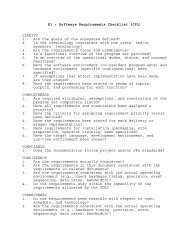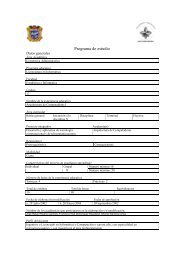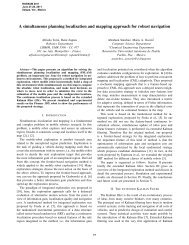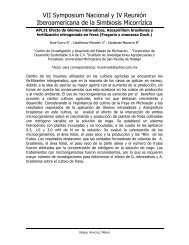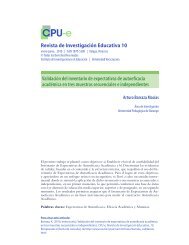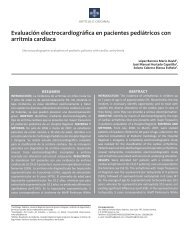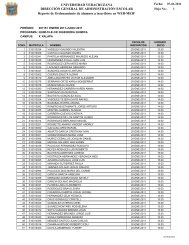Understanding the Software Options
Understanding the Software Options
Understanding the Software Options
Create successful ePaper yourself
Turn your PDF publications into a flip-book with our unique Google optimized e-Paper software.
Solids Processing<br />
Preventing Self-Heating and<br />
Ignition in Drying Operations<br />
Incident investigation reveals that <strong>the</strong><br />
most common root cause is lack of understanding<br />
Pieter Zeeuwen and Vahid Ebadat<br />
Chilworth Global<br />
Many solid materials can<br />
exhibit self-heating, which<br />
— if unchecked — can<br />
progress to a fire or even<br />
explosion. And even if <strong>the</strong> situation<br />
does not get that far, it is likely to affect<br />
<strong>the</strong> output of <strong>the</strong> process, in terms<br />
of product quality degradation, for example.<br />
Recognizing that your product<br />
in powder or granular form can selfheat<br />
is <strong>the</strong> first step in controlling <strong>the</strong><br />
risks associated with self-heating.<br />
Whenever self-heating incidents are<br />
investigated, we find that a common<br />
root cause is a lack of understanding<br />
of self-heating phenomena. This<br />
article provides an introduction to<br />
self-heating phenomena and suggests<br />
measures to control this type of ignition<br />
source.<br />
What is self-heating?<br />
Not all particulate solids that are classified<br />
as combustible dust (in o<strong>the</strong>r<br />
words, pose a dust explosion hazard)<br />
will self-heat at normal processing<br />
temperatures, and conversely, some of<br />
<strong>the</strong> materials that do self-heat react<br />
too slowly to pose a dust explosion<br />
hazard. Some materials can self-heat<br />
at ambient temperatures, especially<br />
in large-scale storage, but for most<br />
materials <strong>the</strong> hazards arise when <strong>the</strong>y<br />
are heated.<br />
Self-heating can arise by one of two<br />
different mechanisms: by exo<strong>the</strong>rmic<br />
(heat releasing) chemical reactions<br />
and by exo<strong>the</strong>rmic decomposition.<br />
The chemical reactions are often <strong>the</strong><br />
same as what occurs during a fire or<br />
explosion: an oxidation reaction with<br />
<strong>the</strong> oxygen in <strong>the</strong> air. At <strong>the</strong> start of<br />
<strong>the</strong> self-heating process, <strong>the</strong> reaction<br />
is very slow, like steel that oxidizes<br />
FIGURE 1. After completion of a test,<br />
in which self-heating of <strong>the</strong> product took<br />
place, <strong>the</strong> product was completely burnt.<br />
The charred and partly molten remains no<br />
longer �t inside <strong>the</strong> sample holder<br />
with atmospheric oxygen to form rust.<br />
Decomposition happens in a material<br />
that is unstable, and <strong>the</strong> material will<br />
fall apart while releasing heat. A significant<br />
difference between <strong>the</strong> two<br />
mechanisms is that decomposition<br />
does not require additional reactants<br />
and is <strong>the</strong>refore largely independent<br />
of <strong>the</strong> environment, while an oxidation<br />
reaction only happens if certain conditions<br />
are present, making it more difficult<br />
to predict its occurrence without<br />
detailed experimental studies.<br />
What happens in self-heating?<br />
Step 1. Rate of heat generation exceeds<br />
rate of heat loss. If a material<br />
undergoes an exo<strong>the</strong>rmic chemical<br />
reaction (or multiple reactions) or decomposes<br />
exo<strong>the</strong>rmically, <strong>the</strong> temperature<br />
of <strong>the</strong> material will rise due to <strong>the</strong><br />
heat released from <strong>the</strong> exo<strong>the</strong>rmic reaction<br />
or decomposition. In <strong>the</strong> meantime,<br />
some of <strong>the</strong> heat is lost to <strong>the</strong><br />
environment. If <strong>the</strong> rate of heat loss<br />
exceeds <strong>the</strong> rate of heat generation,<br />
<strong>the</strong> temperature of <strong>the</strong> material will<br />
be <strong>the</strong> same as <strong>the</strong> ambient temperature,<br />
o<strong>the</strong>rwise, it will increase. Due<br />
to <strong>the</strong> poor <strong>the</strong>rmal conductivities of<br />
many solids, a large portion of <strong>the</strong> re-<br />
FIGURE 2. Product in <strong>the</strong> test cell<br />
(right) is discolored signi�cantly after<br />
<strong>the</strong> test compared to <strong>the</strong> original sample<br />
(left), even though <strong>the</strong> self-heating<br />
has not led to smoldering or burning of<br />
<strong>the</strong> material<br />
FIGURE 3. In this typical test cell for<br />
“bulk” conditions (50-mm dia., 80-mm<br />
height), air can diffuse into <strong>the</strong> sample<br />
through <strong>the</strong> open top of <strong>the</strong> cell and<br />
through <strong>the</strong> bottom of <strong>the</strong> cell, which is<br />
closed with a sintered glass disc. The<br />
sample temperature is measured continuously<br />
at various locations along <strong>the</strong><br />
height of <strong>the</strong> cell<br />
action heat is retained in <strong>the</strong> powder.<br />
Step 2. Resulting temperature<br />
rise fur<strong>the</strong>r increases chemical<br />
reaction rate exponentially. The<br />
temperature rise of <strong>the</strong> material due<br />
to <strong>the</strong> exo<strong>the</strong>rmic reaction will fur<strong>the</strong>r<br />
increase <strong>the</strong> chemical reaction rate,<br />
which in turn will cause <strong>the</strong> temperature<br />
to increase fur<strong>the</strong>r. The increase<br />
of material temperature also results<br />
in an increase in <strong>the</strong> rate of heat loss.<br />
However, <strong>the</strong> rate of heat loss increases<br />
linearly with temperature, while <strong>the</strong><br />
chemical reaction rate, and thus <strong>the</strong><br />
CHEMICAL ENGINEERING WWW.CHE.COM AUGUST 2011 45



